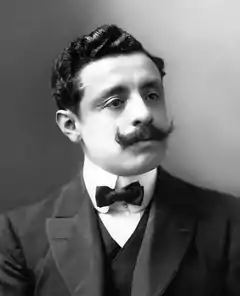Pedro Paulet
Pedro Eleodoro Paulet Mostajo (July 2, 1874 – January 30, 1945) was a Peruvian diplomat who claimed to be the first person to build a liquid-propellant rocket engine and modern rocket propulsion system.[1] [2]
Pedro Paulet | |
|---|---|
 Diplomat | |
| Born | Pedro Eleodoro Paulet Mostajo July 2, 1874 |
| Died | January 30, 1945 (aged 70) |
| Nationality | Peruvian |
| Citizenship | Peruvian |
| Alma mater | University of Paris |
| Scientific career | |
| Fields | Diplomacy |
Career
Paulet's claims were unknown prior to October 27, 1927, when the Peruvian newspaper El Comercio published a letter he wrote, in which he claimed to have conceived a "rocket airplane project" 30 years prior.[3] Recognizing that rocketry was beginning to boom in Europe, Paulet sought witnesses to help corroborate his claims. None came forward, even though Paulet's letter was widely circulated by Alexander Scherschevsky, a Russian national, in summary form. Had Paulet's claims been authenticated, he might today be considered the father of liquid-propellant rocketry, rather than Robert H. Goddard, who in 1926, flew a liquid-fueled rocket engine in a test vehicle.[2]
Legacy
The Peruvian Air Force, in its Aeronautics Museum in Lima, has a "Pedro Paulet Hall" exhibit, where the original sketches and scale models of Paulet’s claimed inventions, are on view. [4]
References
- R. Cargill Hall; International Academy of Astronautics; American Astronautical Society (November 1986). History of rocketry and astronautics: proceedings of the third through the sixth History Symposia of the International Academy of Astronautics. Published for the American Astronautical Society by Univelt, Inc. (P.O. Box 28130, San Diego, Ca. 92128). p. 25. ISBN 978-0-87703-260-1. Retrieved 21 July 2011.
Just how many of his ideas were original and how many derived from these sources it is impossible to determine. Based on information available in October 1969, his claim of having experimented with liquid-propellant rocket motors in Paris in the late 1890s cannot be proved. To date, no actual witnesses have been located, nor any solid evidence uncovered as to the possible existence of the rocket motor.
-
Ordway, III, Frederick I. (October 1969). The Alleged Contributions of Pedro E. Paulet to Liquid-Propellant Rocketry (PDF). Third History Symposium of the International Academy of Astronautics.
Living in Europe in the 1920s, Paulet certainly had an opportunity to become acquainted with the work and writings of German and French rocket and astronautical innovators. Just how many of his ideas were original and how many derived from these sources it is impossible to determine. Based on information available in October 1969, his claim of having experimented with liquid-propellant rocket motors in Paris in the late 1890s cannot be proved. To date, no actual witnesses have been located, nor any solid evidence uncovered as to the possible existence of the rocket motor.
- McMurran, Marshall William (December 2008). Achieving Accuracy: A Legacy of Computers and Missiles. Xlibris Corporation. pp. 187–. ISBN 978-1-4363-8106-2. Retrieved 21 July 2011.
Pedro Paulet, a Peruvian scientist, made the only known claim to liquid propellant rocket engine experiments in the nineteenth century, but he was slow in publishing his work. Finally, in 1927, Paulet wrote a letter to a newspaper in Lima ...
-
Paulet de Vásquez, Sara Madueño (Winter 2001–2002). "Pedro Paulet: Peruvian Space and Rocket Pioneer". Retrieved 2020-07-03.
Sara Madueño heads the Lima bureau of Executive Intelligence Review magazine in Peru and is a long-time political collaborator of international statesman Lyndon H. LaRouche, Jr. She notes that this article is in payment of a long-standing debt to Megan Paulet, daughter of Pedro Paulet, and is written in memory of her own mother, Sara Paulet de Madueño, Pedro Paulet’s niece.